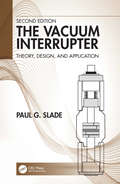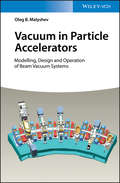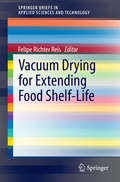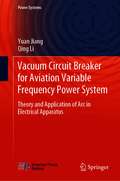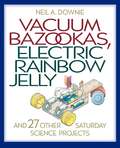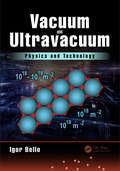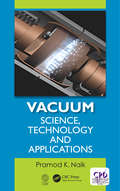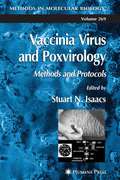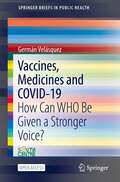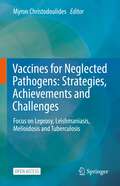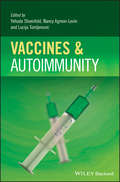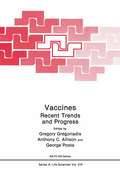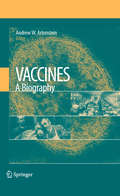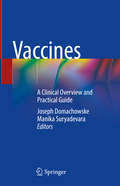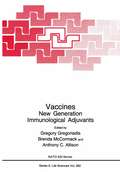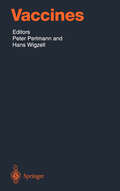- Table View
- List View
The Vacuum Interrupter: Theory, Design, and Application
by Paul G. SladeTitle: The Vacuum Interrupter: Theory, Design, and ApplicationShelving guide: Electrical EngineeringDr. Paul Slade draws from his nearly six decades of active experience to develop this second edition of The Vacuum Interrupter: Theory, Design, and Application. This book begins by discussing the design requirements for high voltage vacuum interrupters and then the contact requirements to interrupt the vacuum arc. It then continues by describing the various applications in which the vacuum interrupter is generally utilized.Part 1 of this book begins with a detailed review of the vacuum breakdown process. It continues by covering the steps necessary for the design and the manufacture of a successful vacuum interrupter. The vacuum arc is then discussed, including how it is affected as a function of current. An overview of the development and use of practical contact materials, along with their advantages and disadvantages, follows. Contact designs that are introduced to control the high current vacuum arc are also analyzed.Part 2, on application, begins with a discussion of the arc interruption process for low current and high current vacuum arcs. It examines the voltage escalation phenomenon that can occur when interrupting inductive circuits. The occurrence of contact welding for closed contacts subjected to the passage of high currents, and for contacts when closing on high currents, is explored. The general requirements for the successful manufacture and testing of vacuum circuit breakers is then presented. The general application of vacuum interrupters to switch load currents, especially when applied to capacitor circuits, is also given. The interruption of high short circuit currents is presented along with the expected performance of the two major contact designs.Owing to the ever-increasing need for environmentally friendly circuit protection devices, the development and application of the vacuum interrupter will only increase in the future. At present the vacuum circuit breaker is the technology of choice for distribution circuits (5kV to 40.5kV). It is increasingly being applied to transmission circuits (72.5kV to 242kV). In the future, its application for protecting high voltage DC networks is assured.Audience This is a practical source book for engineers and scientists interested in studying the development and application of the vacuum interrupter Research scientists in industry and universities Graduate students beginning their study of vacuum interrupter phenomena Design engineers applying vacuum interrupters in vacuum switches, vacuum contactors, vacuum circuit breakers, and vacuum contactors It provides a unique and comprehensive review of all aspects of vacuum interrupter technology for those new to the subject and for those who wish to obtain a deeper understanding of its science and application Scientists and engineers, who are beginning their research into vacuum breakdown and aspects of the vacuum arc, will find the extensive bibliography and phenomenological descriptions to be a useful introduction
The Vacuum Interrupter: Theory, Design, and Application
by Paul G. SladeTitle: The Vacuum Interrupter: Theory, Design, and ApplicationShelving guide: Electrical EngineeringDr. Paul Slade draws from his nearly six decades of active experience to develop this second edition of The Vacuum Interrupter: Theory, Design, and Application. This book begins by discussing the design requirements for high voltage vacuum interrupters and then the contact requirements to interrupt the vacuum arc. It then continues by describing the various applications in which the vacuum interrupter is generally utilized.Part 1 of this book begins with a detailed review of the vacuum breakdown process. It continues by covering the steps necessary for the design and the manufacture of a successful vacuum interrupter. The vacuum arc is then discussed, including how it is affected as a function of current. An overview of the development and use of practical contact materials, along with their advantages and disadvantages, follows. Contact designs that are introduced to control the high current vacuum arc are also analyzed.Part 2, on application, begins with a discussion of the arc interruption process for low current and high current vacuum arcs. It examines the voltage escalation phenomenon that can occur when interrupting inductive circuits. The occurrence of contact welding for closed contacts subjected to the passage of high currents, and for contacts when closing on high currents, is explored. The general requirements for the successful manufacture and testing of vacuum circuit breakers is then presented. The general application of vacuum interrupters to switch load currents, especially when applied to capacitor circuits, is also given. The interruption of high short circuit currents is presented along with the expected performance of the two major contact designs.Owing to the ever-increasing need for environmentally friendly circuit protection devices, the development and application of the vacuum interrupter will only increase in the future. At present the vacuum circuit breaker is the technology of choice for distribution circuits (5kV to 40.5kV). It is increasingly being applied to transmission circuits (72.5kV to 242kV). In the future, its application for protecting high voltage DC networks is assured.Audience This is a practical source book for engineers and scientists interested in studying the development and application of the vacuum interrupter Research scientists in industry and universities Graduate students beginning their study of vacuum interrupter phenomena Design engineers applying vacuum interrupters in vacuum switches, vacuum contactors, vacuum circuit breakers, and vacuum contactors It provides a unique and comprehensive review of all aspects of vacuum interrupter technology for those new to the subject and for those who wish to obtain a deeper understanding of its science and application Scientists and engineers, who are beginning their research into vacuum breakdown and aspects of the vacuum arc, will find the extensive bibliography and phenomenological descriptions to be a useful introduction
Vacuum in Particle Accelerators: Modelling, Design and Operation of Beam Vacuum Systems
by Oleg B. MalyshevA unique guide on how to model and make the best vacuum chambers Vacuum in Particle Accelerators offers a comprehensive overview of ultra-high vacuum systems that are used in charge particle accelerators. The book?s contributors ? noted experts in the field ? also highlight the design and modeling of vacuum particle accelerators. The book reviews vacuum requirements, identifies sources of gas in vacuum chambers and explores methods of removing them. In addition, Vacuum in Particle Accelerators offers an in-depth explanation of the control of the beam and the beam aperture. In the final part of the book, the focus is on the modelling approaches for vacuum chambers under various operating conditions. This important guide: -Offers a review of vacuum systems in charge particle accelerators -Contains contributions from an international panel of noted experts in the field -Highlights the systems, modelling, and design of vacuum particle accelerators -Includes information on vacuum requirements, beam-gas interactions, cryogenic temperatures, ion induced pressure instability, heavy ion machines -Presents the most up-to-date information on the topic for scientists and engineers Written for vacuum physicists, vacuum engineers, plasma physicists, materials scientists, and engineering scientists, Vacuum Particle Accelerators is an essential reference offering an in-depth exploration of vacuum systems and the modelling and design of charged particle accelerators.
Vacuum in Particle Accelerators: Modelling, Design and Operation of Beam Vacuum Systems
by Oleg B. MalyshevA unique guide on how to model and make the best vacuum chambers Vacuum in Particle Accelerators offers a comprehensive overview of ultra-high vacuum systems that are used in charge particle accelerators. The book?s contributors ? noted experts in the field ? also highlight the design and modeling of vacuum particle accelerators. The book reviews vacuum requirements, identifies sources of gas in vacuum chambers and explores methods of removing them. In addition, Vacuum in Particle Accelerators offers an in-depth explanation of the control of the beam and the beam aperture. In the final part of the book, the focus is on the modelling approaches for vacuum chambers under various operating conditions. This important guide: -Offers a review of vacuum systems in charge particle accelerators -Contains contributions from an international panel of noted experts in the field -Highlights the systems, modelling, and design of vacuum particle accelerators -Includes information on vacuum requirements, beam-gas interactions, cryogenic temperatures, ion induced pressure instability, heavy ion machines -Presents the most up-to-date information on the topic for scientists and engineers Written for vacuum physicists, vacuum engineers, plasma physicists, materials scientists, and engineering scientists, Vacuum Particle Accelerators is an essential reference offering an in-depth exploration of vacuum systems and the modelling and design of charged particle accelerators.
Vacuum Flask (UEB uncontracted)
by RnibThis is a labelled cross section diagram of a vacuum flask (also called a Dewar flask or Thermos flask) seen from the side. There is a locator dot shown, which will be at the top left of the page when the image is the correct way up. The image of the flask fills the right half of the page. On the left of the page are descriptive labels with leader lines pointing to parts of the flask on the right.
Vacuum Flask (UEB contracted)
by RnibThis is a labelled cross section diagram of a vacuum flask (also called a Dewar flask or Thermos flask) seen from the side. There is a locator dot shown, which will be at the top left of the page when the image is the correct way up. The image of the flask fills the right half of the page. On the left of the page are descriptive labels with leader lines pointing to parts of the flask on the right.
Vacuum Flask (large print)
by RnibThis is a labelled cross section diagram of a vacuum flask (also called a Dewar flask or Thermos flask) seen from the side. There is a locator dot shown, which will be at the top left of the page when the image is the correct way up. The image of the flask fills the right half of the page. On the left of the page are descriptive labels with leader lines pointing to parts of the flask on the right.
Vacuum Drying for Extending Food Shelf-Life (SpringerBriefs in Applied Sciences and Technology)
by Felipe Richter ReisIn this book, suitable examples of how to increase the shelf life of food materials while preserving their desirable original features are provided.
Vacuum Circuit Breaker for Aviation Variable Frequency Power System: Theory and Application of Arc in Electrical Apparatus (Power Systems)
by Qing Li Yuan JiangThis book introduces the concepts of more electric aircraft and aviation electrical appliances, as well as the aviation experimental platform of vacuum switches, the interruption characteristics, frequency characteristics and post-arc breakdown characteristics of intermediate frequency vacuum switches, etc. It is the first monograph on protection electrical appliances, vacuum interrupter in aviation variable frequency power system. This book includes a lot of experimental process and chart analysis for readers to understand and provides references for practical engineering problems. This book could be used as references for engineers and technicians working on electric power systems in aircrafts.
Vacuum Bazookas, Electric Rainbow Jelly, and 27 Other Saturday Science Projects (PDF)
by Neil A. DownieHow do you crack nuts with a piece of string? Reverse gravity? Cobble together a clock out of a coffee cup, a soda bottle, and some water? Use a vacuum cleaner and nineteenth-century railroad technology to fashion a makeshift bazooka that can launch paper projectiles? Create a rainbow in a block of Jello? This is a one-volume romp through a whole array of counterintuitive science experiments that require little more than common household items and a sense of curiosity. Prepare to have your surprise sensors on overload as Neil Downie stretches math, physics, and chemistry to do what they have never done before. This book describes twenty-nine unusual but practical experiments, detailing how they are done and the math and physics behind them. It will delight both casual and inveterate tinkerers. Of varying levels of complexity, the experiments are grouped in sections covering a wide field of physics and the borders of chemistry, ranging from dynamic mechanics (''Kinetic Curiosities'') to electricity (''Antediluvian Electronics'') and combustion (''Infernal Inventions''). The chapters are titillatingly titled, from ''Twisted Sinews'' and ''Mole Radio'' to ''A Symphony of Siphons'' and ''Tornado Transistor.'' More-detailed explanations, along with simple mathematical models using high-school level math, are given in boxes accompanying each experiment. Armchair scientists will welcome this edifying and entertaining alternative to idleness, not least for the buoyant prose, enriched by historical and literary anecdotes introducing each topic. With this book in hand, tinkerers, whether dabblers in science or devotees, students or teachers, need never again wonder how to impress friends, the judges at the science fair, and, not least, themselves.
Vacuum Bazookas, Electric Rainbow Jelly, and 27 Other Saturday Science Projects
by Neil A. DownieHow do you crack nuts with a piece of string? Reverse gravity? Cobble together a clock out of a coffee cup, a soda bottle, and some water? Use a vacuum cleaner and nineteenth-century railroad technology to fashion a makeshift bazooka that can launch paper projectiles? Create a rainbow in a block of Jello? This is a one-volume romp through a whole array of counterintuitive science experiments that require little more than common household items and a sense of curiosity. Prepare to have your surprise sensors on overload as Neil Downie stretches math, physics, and chemistry to do what they have never done before. This book describes twenty-nine unusual but practical experiments, detailing how they are done and the math and physics behind them. It will delight both casual and inveterate tinkerers. Of varying levels of complexity, the experiments are grouped in sections covering a wide field of physics and the borders of chemistry, ranging from dynamic mechanics (''Kinetic Curiosities'') to electricity (''Antediluvian Electronics'') and combustion (''Infernal Inventions''). The chapters are titillatingly titled, from ''Twisted Sinews'' and ''Mole Radio'' to ''A Symphony of Siphons'' and ''Tornado Transistor.'' More-detailed explanations, along with simple mathematical models using high-school level math, are given in boxes accompanying each experiment. Armchair scientists will welcome this edifying and entertaining alternative to idleness, not least for the buoyant prose, enriched by historical and literary anecdotes introducing each topic. With this book in hand, tinkerers, whether dabblers in science or devotees, students or teachers, need never again wonder how to impress friends, the judges at the science fair, and, not least, themselves.
Vacuum and Ultravacuum: Physics and Technology
by Igor BelloVacuum technology has enormous impact on human life in many aspects and fields, such as metallurgy, material development and production, food and electronic industry, microelectronics, device fabrication, physics, materials science, space science, engineering, chemistry, technology of low temperature, pharmaceutical industry, and biology. All decorative coatings used in jewelries and various daily products—including shiny decorative papers, the surface finish of watches, and light fixtures—are made using vacuum technological processes. Vacuum analytical techniques and vacuum technologies are pillars of the technological processes, material synthesis, deposition, and material analyses—all of which are used in the development of novel materials, increasing the value of industrial products, controlling the technological processes, and ensuring the high product quality. Based on physical models and calculated examples, the book provides a deeper look inside the vacuum physics and technology.
Vacuum and Ultravacuum: Physics and Technology
by Igor BelloVacuum technology has enormous impact on human life in many aspects and fields, such as metallurgy, material development and production, food and electronic industry, microelectronics, device fabrication, physics, materials science, space science, engineering, chemistry, technology of low temperature, pharmaceutical industry, and biology. All decorative coatings used in jewelries and various daily products—including shiny decorative papers, the surface finish of watches, and light fixtures—are made using vacuum technological processes. Vacuum analytical techniques and vacuum technologies are pillars of the technological processes, material synthesis, deposition, and material analyses—all of which are used in the development of novel materials, increasing the value of industrial products, controlling the technological processes, and ensuring the high product quality. Based on physical models and calculated examples, the book provides a deeper look inside the vacuum physics and technology.
Vacuum: Science, Technology and Applications
by Pramod K. NaikVacuum plays an important role in science and technology. The study of interaction of charged particles, neutrals and radiation with each other and with solid surfaces requires a vacuum environment for reliable investigations. Vacuum has contributed immensely to advancements made in nuclear science, space, metallurgy, electrical/electronic technology, chemical engineering, transportation, robotics and many other fields. This book is intended to assist students, scientists, technicians and engineers to understand the basics of vacuum science and technology for application in their projects. The fundamental theories, concepts, devices, applications, and key inventions are discussed.
Vacuum: Science, Technology and Applications
by Pramod K. NaikVacuum plays an important role in science and technology. The study of interaction of charged particles, neutrals and radiation with each other and with solid surfaces requires a vacuum environment for reliable investigations. Vacuum has contributed immensely to advancements made in nuclear science, space, metallurgy, electrical/electronic technology, chemical engineering, transportation, robotics and many other fields. This book is intended to assist students, scientists, technicians and engineers to understand the basics of vacuum science and technology for application in their projects. The fundamental theories, concepts, devices, applications, and key inventions are discussed.
Vaccinia Virus and Poxvirology: Methods and Protocols (Methods in Molecular Biology #269)
by Stuart N. IsaacsThe Right Book at the Right Time The poxviruses comprise a family of complex DNA viruses that replicate in the cytoplasm of vertebrate or invertebrate cells. Of the eight recognized g- era of vertebrate poxviruses, those belonging to the orthopoxvirus genus have been most intensively studied. This group includes variola virus, the agent of smallpox, as well as cowpox virus and vaccinia virus. Jenner’s original sma- pox vaccine, described in 1798, consisted of live cowpox virus, but vaccinia virus later replaced it (1). There has been speculation as to the origin of v- cinia virus; the most likely idea is that it is a separate species, possibly ori- nally isolated from a horse, and is now extinct or rare in nature (2). Recent genome sequencing studies confirm the distinctness of variola virus, cowpox virus, and vaccinia virus and also their very close genetic relationship, which accounts for the cross protection of smallpox vaccines. The novelty of the smallpox vaccine can be readily appreciated by the time it took, about 80 years, before the next live vaccine against rabies was developed, and another 50 years for the yellow fever vaccine. Moreover, the eradication of smallpox in 1977 stands as a unique medical achievement. Because of its historical role, sma- pox vaccination contributed greatly to present concepts of infectious disease, immunity, and pathogenesis. Less well known, however, are the many other “firsts” for vaccinia virus.
Vaccines, Medicines and COVID-19: How Can WHO Be Given a Stronger Voice? (SpringerBriefs in Public Health)
by Germán VelásquezThis open access book is a collection of research papers on COVID-19 by Germán Velásquez from 2020 and early 2021 that help to answer the question: How can an agency like the World Health Organization (WHO) be given a stronger voice to exercise authority and leadership? The considerable health, economic and social challenges that the world faced at the beginning of 2020 with COVID-19 continued and worsened in many parts of the world in the second-half of 2020 and into 2021. Many of these countries and nations wanted to explore COVID-19 on their own, sometimes without listening to the main international health bodies such as WHO, an agency of the United Nations system with long-standing experience and vast knowledge at the global level and of which all countries in the world are members. In this single volume, the chapters present the progress of thinking and debate — particularly in relation to drugs and vaccines — that would enable a response to the COVID-19 pandemic or to subsequent crises that may arise. Among the topics covered:COVID-19 Vaccines: Between Ethics, Health and EconomicsMedicines and Intellectual Property: 10 Years of the WHO Global StrategyRe-thinking Global and Local Manufacturing of Medical Products After COVID-19Rethinking R&D for Pharmaceutical Products After the Novel Coronavirus COVID-19 ShockIntellectual Property and Access to Medicines and VaccinesThe World Health Organization Reforms in the Time of COVID-19Vaccines, Medicines and COVID-19: How Can WHO Be Given a Stronger Voice? is essential reading for negotiators from the 194 member countries of the World Health Organization (WHO); World Trade Organization (WTO) and World Intellectual Property Organization (WIPO) staff participating in these negotiations; academics and students of public health, medicine, health sciences, law, sociology and political science; and intergovernmental organizations and non-governmental organizations that follow the issue of access to treatments and vaccines for COVID-19.
Vaccines for Neglected Pathogens: Focus on Leprosy, Leishmaniasis, Melioidosis and Tuberculosis
by Myron ChristodoulidesThis book reviews successes and (remaining) challenges in vaccine development for the selected Neglected Tropical Diseases (NTD) of Leprosy, Leishmaniasis, Meliodoisis and Tuberculosis, which are a continuous burden for millions of people in affected areas worldwide. Written by frontline researchers, the volume deep-dives into different vaccine strategies, provides biotechnological background information and also tackles animal models in NTD therapeutics research. By bringing together state-of-the-art expert knowledge, the book contributes to the aim of ultimately ending the epidemics of neglected tropical diseases, complying with UN Sustainable Development Goal 3, Health and Well-Being.The volume highlights the activities of the research network VALIDATE (VAccine deveLopment for complex Intracellular neglecteD pAThogEns), funded by the Medical Research Council in the UK. The four NTDs discussed in the book were selected as these are in the focus of VALIDATE’s research.The book targets scientists and clinicians working on NTDs, as well as all readers with a background in biomedicine and interest in vaccine development.This is an open access book.
Vaccines and Autoimmunity
by Yehuda Shoenfeld Nancy Agmon-Levin Lucija TomljenovicIn light of the discovery of Autoimmune Syndrome Induced by Adjuvants, or ASIA, Vaccines and Autoimmunity explores the role of adjuvants – specifically aluminum in different vaccines – and how they can induce diverse autoimmune clinical manifestations in genetically prone individuals. Vaccines and Autoimmunity is divided into three sections; the first contextualizes the role of adjuvants in the framework of autoimmunity, covering the mechanism of action of adjuvants, experimental models of adjuvant induced autoimmune diseases, infections as adjuvants, the Gulf War Syndrome, sick-building syndrome (SBS), safe vaccines, toll-like receptors, TLRS in vaccines, pesticides as adjuvants, oil as adjuvant, mercury, aluminum and autoimmunity. The following section reviews literature on vaccines that have induced autoimmune conditions such as MMR and HBV, among others. The final section covers diseases in which vaccines were known to be the solicitor – for instance, systemic lupus erythematosus – and whether it can be induced by vaccines for MMR, HBV, HCV, and others. Edited by leaders in the field, Vaccines and Autoimmunity is an invaluable resource for advanced students and researchers working in pathogenic and epidemiological studies.
Vaccines and Autoimmunity
by Yehuda Shoenfeld Nancy Agmon-Levin Lucija TomljenovicIn light of the discovery of Autoimmune Syndrome Induced by Adjuvants, or ASIA, Vaccines and Autoimmunity explores the role of adjuvants – specifically aluminum in different vaccines – and how they can induce diverse autoimmune clinical manifestations in genetically prone individuals. Vaccines and Autoimmunity is divided into three sections; the first contextualizes the role of adjuvants in the framework of autoimmunity, covering the mechanism of action of adjuvants, experimental models of adjuvant induced autoimmune diseases, infections as adjuvants, the Gulf War Syndrome, sick-building syndrome (SBS), safe vaccines, toll-like receptors, TLRS in vaccines, pesticides as adjuvants, oil as adjuvant, mercury, aluminum and autoimmunity. The following section reviews literature on vaccines that have induced autoimmune conditions such as MMR and HBV, among others. The final section covers diseases in which vaccines were known to be the solicitor – for instance, systemic lupus erythematosus – and whether it can be induced by vaccines for MMR, HBV, HCV, and others. Edited by leaders in the field, Vaccines and Autoimmunity is an invaluable resource for advanced students and researchers working in pathogenic and epidemiological studies.
Vaccines: Recent Trends and Progress (Nato Science Series A: #215)
by Anthony C. Allison Gregory Gregoriadis George PosteThe success of vaccination in controlling infectious diseases is well documented. However, low profitability, expense and liability have hindered research and development of vaccines. Recently, increasing realization (enhanced by the AIDS pandemic) of the need to overcome such difficulties has led to steps being taken by national authorities, non-profit and commercial organizations to resolve them. This has been facilitated by developments in recombinant DNA techniques, the advent of monoclonal anti bodies and progress in the understanding of the immunological structure of proteins which have laid the foundation of a new generation of vaccines. Such vaccines are defined at the molecular level, can elicit immune responses controlling infectious organisms and are therefore potentially free of the problems encountered in conventional ones. Unfortunately, subunit and synthetic peptide vaccines are often only weakly or non inmunogenic. However, developments in both antigen production and immuno potentiation of weak antigens have opened new avenues with exciting prospects for vaccine design.
Vaccines: A Biography
by Andrew W. ArtensteinWhy another book about vaccines? There are already a few extremely well-written medical textbooks that provide comprehensive, state-of-the-art technical reviews regarding vaccine science. Additionally, in the past decade alone, a number of engrossing, provocative books have been published on various related issues ra- ing from vaccines against specific diseases to vaccine safety and policy. Yet there remains a significant gap in the literature – the history of vaccines. Vaccines: A Biography seeks to fill a void in the extant literature by focusing on the history of vaccines and in so doing, recounts the social, cultural, and scientific history of vaccines; it places them within their natural, historical context. The book traces the lineage – the “biography” – of individual vaccines, originating with deeply rooted medical problems and evolving to an eventual conclusion. Nonetheless, these are not “biographies” in the traditional sense; they do not trace an individual’s growth and development. Instead, they follow an idea as it is conceived and dev- oped, through the contributions of many. These are epic stories of discovery, of risk-takers, of individuals advancing medical science, in the words of the famous physical scientist Isaac Newton, “by standing on the shoulders of giants. ” One grant reviewer described the book’s concept as “triumphalist”; although meant as an indictment, this is only partially inaccurate.
Vaccines: A Clinical Overview and Practical Guide
by Joseph Domachowske Manika SuryadevaraThis book is designed to provide easy-to-read and basic information about vaccines for those undertaking a vaccine course or for medical providers seeking to improve their skills. Written by expert medical educators in the areas of infectious diseases, medical microbiology, and pediatrics, this book begins by establishing the fundamentals of vaccines such as what constitutes a vaccine, how they are manufactured and composed, how they are tested for safety and efficacy, and how vaccine recommendations are developed and conveyed to health care providers and their patients. The book then explains the composition, safety profile, effectiveness, and current recommendations for use of every available vaccine, alphabetized by infection. The concluding section illuminates practical concerns every vaccinating clinician experiences, including vaccine confidence and hesitancy, misconceptions, and patient communication. Vaccines: A Clinical Overview and Practical Guide is an excellent learning tool for all students and providers administering vaccines to patients, including infectious disease specialists and other internal medicine subspecialists, pediatricians, geriatricians, as well as all other primary care physicians, nurse practitioners, physician’s assistants, and nurses.
Vaccines: New Generation Immunological Adjuvants (Nato Science Series A: #282)
by Gregory Gregoriadis Brenda McCormack Anthony C. AllisonDuring the last decade or so vaccine development has been facilitated by rapid advances in molecular and cell biology. These have laid the foundations of a new generation of vaccines exemplified by subunit vaccines produced through gene cloning and by synthetic peptides mimicking small regions of proteins on the outer coat of viruses. Such peptide~ are capable of eliciting virus-neutralizing antibodies. Unfortunately, subunit and peptide vaccines are only weakly or non immunogenic in the absence of immunological adjuvants that are known to augment specific cell-mediated immune responses to the antigens and to promote the formation of protective antibodies. This book contains the proceedings of the 4th NATO Advanced Studies Institute (ASI) "Vaccines: New Generation Immunological Adjuvants" held at Cape Sounion Beach, Greece, during 24 June -5 . July 1994 and deals in depth with both theoretical and practical aspects of vaccinology. These include the role of antigen presenting cells in the induction of immune responses. immunopotentiation by a variety of new generation immunological adjuvants and vaccine carriers. and recent advances and perspectives in experimental vaccines as well as vaccinatioll with nucleic acids. We express our appreciation to Dr. K. Dalsgaard and Dr. J. L. Virelizier for their cooperatioll in planning the ASI and to Mrs. Concha Pening for her excellent production of the manuscripts. The ASI was held under the sponsorship of NATO Scientific Affairs Division and generously co-sponsored by SmithKline Beecham Pharmaceuticals (Philadelphia).
Vaccines (Handbook of Experimental Pharmacology #133)
by Peter Perlman Hans WigzellThe immune system is the only organ system in the body besides the central nervous systems endowed with memory. Both types of memories are specific and long-lasting, sometimes life long. This memory capacity of the immune system provides the basis for the most cost-efficient of all medical interventions, successful vaccinations against many common infectious diseases. Such a success requires the isolation of the infectious agent or toxic substance, methods to grow and/or purify the relevant antigen and change it into something innocuous whilst maintaining its immunogenicity. Whereas the early vaccines could only use the enhanced resistance against infectious disease as a measure of vaccine efficacy, most modern vaccines rely upon standardized laboratory tests accepted to parallel the in vivo protective capacity to confirm the quality and potency of the respective vaccine. We are presently experiencing an explosion in the development of new and/or improved vaccines. This is largely due to a parallel rapid expansion in our knowledge of the immune system and of the detailed molecular structure and function of microorganisms. Using this knowledge it is now possible to compose vaccines of new types where only certain molecules (or parts of molecules) derived from a pathogen are included, excluding other potentially harmful ones. Whereas earlier attenuated live vaccines were created by em pirical means such vaccines can now be created by molecularly defined inter ventions in the genome of the microorganism.
